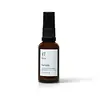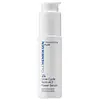What's inside
What's inside
 Key Ingredients
Key Ingredients

 Benefits
Benefits

 Concerns
Concerns

 Ingredients Side-by-side
Ingredients Side-by-side

Water
Skin ConditioningGlycerin
HumectantCyclopentasiloxane
EmollientCaprylic/Capric Triglyceride
MaskingDimethicone
EmollientGlyceryl Stearate
EmollientCeteareth-20
CleansingCetearyl Alcohol
EmollientGlucosamine
Silver
Cosmetic ColorantLactic Acid
BufferingPEG-100 Stearate
Triethanolamine 1%
BufferingPhenoxyethanol
PreservativeButyrospermum Parkii Butter
Skin ConditioningEthylhexylglycerin
Skin ConditioningChitosan
Limonene
PerfumingAllantoin
Skin ConditioningCitrus Tangerina Peel Oil
MaskingCitrus Aurantium Bergamia Peel Oil
Citrus Grandis Peel Oil
MaskingCitrus Aurantium Dulcis Peel Oil
MaskingCitral
PerfumingLinalool
PerfumingSilver Chloride
PreservativeCitronellol
PerfumingGeraniol
PerfumingWater, Glycerin, Cyclopentasiloxane, Caprylic/Capric Triglyceride, Dimethicone, Glyceryl Stearate, Ceteareth-20, Cetearyl Alcohol, Glucosamine, Silver, Lactic Acid, PEG-100 Stearate, Triethanolamine 1%, Phenoxyethanol, Butyrospermum Parkii Butter, Ethylhexylglycerin, Chitosan, Limonene, Allantoin, Citrus Tangerina Peel Oil, Citrus Aurantium Bergamia Peel Oil, Citrus Grandis Peel Oil, Citrus Aurantium Dulcis Peel Oil, Citral, Linalool, Silver Chloride, Citronellol, Geraniol
Water
Skin ConditioningPropanediol
SolventGlycerin
HumectantSqualane
EmollientGlycereth-26
HumectantGlyceryl Polyacrylate
Mica
Cosmetic ColorantCetearyl Alcohol
EmollientBakuchiol
AntimicrobialPolyacrylate Crosspolymer-6
Emulsion StabilisingDimethicone
EmollientPolyglyceryl-10 Laurate
Skin ConditioningAminomethyl Propanol
BufferingHydrolyzed Jojoba Esters
Skin ConditioningPhenoxyethanol
PreservativeHydroxyacetophenone
AntioxidantParfum
MaskingCeteareth-20
CleansingGlycolic Acid
BufferingLactic Acid
BufferingLeontopodium Alpinum Callus Culture Extract
AntioxidantCaesalpinia Spinosa Fruit Extract
Skin ProtectingCellulose Gum
Emulsion StabilisingHibiscus Sabdariffa Flower Extract
Skin ConditioningKappaphycus Alvarezii Extract
Skin ConditioningSilica
AbrasiveGlycyrrhiza Glabra Root Extract
BleachingCitrus Limon Fruit Extract
MaskingSaccharum Officinarum Extract
MoisturisingChamomilla Recutita Flower Extract
MaskingSantalum Album Extract
CleansingTrisodium Ethylenediamine Disuccinate
Leuconostoc/Radish Root Ferment Filtrate
AntimicrobialXanthan Gum
EmulsifyingEthylhexylglycerin
Skin ConditioningCitric Acid
BufferingLimonene
PerfumingLinalool
PerfumingCitral
PerfumingCI 77891
Cosmetic ColorantCI 60730
Cosmetic ColorantCI 14700
Cosmetic ColorantWater, Propanediol, Glycerin, Squalane, Glycereth-26, Glyceryl Polyacrylate, Mica, Cetearyl Alcohol, Bakuchiol, Polyacrylate Crosspolymer-6, Dimethicone, Polyglyceryl-10 Laurate, Aminomethyl Propanol, Hydrolyzed Jojoba Esters, Phenoxyethanol, Hydroxyacetophenone, Parfum, Ceteareth-20, Glycolic Acid, Lactic Acid, Leontopodium Alpinum Callus Culture Extract, Caesalpinia Spinosa Fruit Extract, Cellulose Gum, Hibiscus Sabdariffa Flower Extract, Kappaphycus Alvarezii Extract, Silica, Glycyrrhiza Glabra Root Extract, Citrus Limon Fruit Extract, Saccharum Officinarum Extract, Chamomilla Recutita Flower Extract, Santalum Album Extract, Trisodium Ethylenediamine Disuccinate, Leuconostoc/Radish Root Ferment Filtrate, Xanthan Gum, Ethylhexylglycerin, Citric Acid, Limonene, Linalool, Citral, CI 77891, CI 60730, CI 14700
Ingredients Explained
These ingredients are found in both products.
Ingredients higher up in an ingredient list are typically present in a larger amount.
Ceteareth-20 is an emulsifier and cleansing agent. It is derived from cetearyl alcohol, a fatty alcohol.
As an emulsifier, Ceteareth-20 prevents oil and water from separating. It is also a surfactant. Surfactants help gather oil, pollution, and dirt to be washed away.
Cetearyl alcohol is a mixture of two fatty alcohols: cetyl alcohol and stearyl alcohol. It is mainly used as an emulsifier. Emulsifiers help prevent the separation of oils and products. Due to its composition, it can also be used to thicken a product or help create foam.
Cetearyl alcohol is an emollient. Emollients help soothe and hydrate the skin by trapping moisture.
Studies show Cetearyl alcohol is non-toxic and non-irritating. The FDA allows products labeled "alcohol-free" to have fatty alcohols.
This ingredient is usually derived from plant oils such as palm, vegetable, or coconut oils. There is debate on whether this ingredient will cause acne.
Due to the fatty acid base, this ingredient may not be Malassezia folliculitis safe.
Learn more about Cetearyl AlcoholCitral is a fragrance and used to add a lemon-like scent to products. It is both naturally found in plants and created synthetically. In plants, it is commonly occurring in lemon myrtle, lemongrass, lemon tea-tree, lemon verbena, and other citruses.
The EU mandates Citral be listed separately as a fragrance. It is a known allergen and may cause contact dermatitis. Citral can also used as a masking ingredient.
The term 'fragrance' is not regulated in many countries. In many cases, it is up to the brand to define this term. For instance, many brands choose to label themselves as "fragrance-free" because they are not using synthetic fragrances. However, their products may still contain ingredients such as essential oils that are considered a fragrance.
The term 'citral' is a collective term for two geometric isomers: geranial/Citral A and neral/Citral B.
Learn more about CitralDimethicone is a type of synthetic silicone created from natural materials such as quartz.
What it does:
Dimethicone comes in different viscosities:
Depending on the viscosity, dimethicone has different properties.
Ingredients lists don't always show which type is used, so we recommend reaching out to the brand if you have questions about the viscosity.
This ingredient is unlikely to cause irritation because it does not get absorbed into skin. However, people with silicone allergies should be careful about using this ingredient.
Note: Dimethicone may contribute to pilling. This is because it is not oil or water soluble, so pilling may occur when layered with products. When mixed with heavy oils in a formula, the outcome is also quite greasy.
Learn more about DimethiconeEthylhexylglycerin (we can't pronounce this either) is commonly used as a preservative and skin softener. It is derived from glyceryl.
You might see Ethylhexylglycerin often paired with other preservatives such as phenoxyethanol. Ethylhexylglycerin has been found to increase the effectiveness of these other preservatives.
Glycerin is already naturally found in your skin. It helps moisturize and protect your skin.
A study from 2016 found glycerin to be more effective as a humectant than AHAs and hyaluronic acid.
As a humectant, it helps the skin stay hydrated by pulling moisture to your skin. The low molecular weight of glycerin allows it to pull moisture into the deeper layers of your skin.
Hydrated skin improves your skin barrier; Your skin barrier helps protect against irritants and bacteria.
Glycerin has also been found to have antimicrobial and antiviral properties. Due to these properties, glycerin is often used in wound and burn treatments.
In cosmetics, glycerin is usually derived from plants such as soybean or palm. However, it can also be sourced from animals, such as tallow or animal fat.
This ingredient is organic, colorless, odorless, and non-toxic.
Glycerin is the name for this ingredient in American English. British English uses Glycerol/Glycerine.
Learn more about GlycerinLactic Acid is another well-loved alpha hydroxy acid (AHA). It is gentler than glycolic acid but still highly effective.
Its main role is to exfoliate the surface of the skin by loosening the “glue” that holds dead skin cells together. Shedding those old cells leads to smoother, softer, and more even-toned skin.
Because lactic acid molecules are larger than glycolic acid, they don’t penetrate as deeply. This means they’re less likely to sting or irritate, making it a great choice for beginners or those with sensitive skin.
Like glycolic acid, it can:
Lactic acid also acts as a humectant (like hyaluronic acid). It can draw water into the skin to improve hydration and also plays a role in the skin's natural moisturizing factor (NMF) in the form of sodium lactate.
Studies show it can boost ceramide production to strengthen the skin barrier and even help balance the skin’s microbiome.
To get results, choose products with a pH between 3-4.
Lower strengths (5-12%) focus on surface exfoliation; higher strengths (12% and up) can reach deeper in the dermis (deeper, supportive layer) to improve skin texture and firmness over time.
Though it was originally derived from milk, most modern lactic acid used in skincare is vegan. It is made through non-dairy fermentation to create a bio-identical and stable form suitable for all formulations.
When lactic acid shows up near the end of an ingredient list, it usually means the brand added just a tiny amount to adjust the product’s pH.
Legend has it that Cleopatra used to bathe in sour milk to help reduce wrinkles.
Lactic acid is truly a gentle multitasker: it exfoliates, hydrates, strengthens, and brightens. It's a great ingredient for giving your skin a smooth, glowing, and healthy look without the harshness of stronger acids.
Read more about some other popular AHA's here:
Learn more about Lactic AcidLimonene is a fragrance that adds scent and taste to a formulation.
It's found in the peel oil of citrus fruits and other plants such as lavender and eucalyptus. The scent of limonene is generally described as "sweet citrus".
Limonene acts as an antioxidant, meaning it helps neutralize free radicals.
When exposed to air, oxidized limonene may sensitize the skin. Because of this, limonene is often avoided by people with sensitive skin.
The term 'fragrance' is not regulated in many countries. In many cases, it is up to the brand to define this term. For instance, many brands choose to label themselves as "fragrance-free" because they are not using synthetic fragrances. However, their products may still contain ingredients such as essential oils that are considered a fragrance.
Learn more about LimoneneLinalool is a fragrance and helps add scent to products. It's derived from common plants such as cinnamon, mint, citrus, and lavender.
Like Limonene, this ingredient oxidizes when exposed to air. Oxidized linalool can cause allergies and skin sensitivity.
This ingredient has a scent that is floral, spicy tropical, and citrus-like.
Learn more about LinaloolPhenoxyethanol is a preservative that has germicide, antimicrobial, and aromatic properties. Studies show that phenoxyethanol can prevent microbial growth. By itself, it has a scent that is similar to that of a rose.
It's often used in formulations along with Caprylyl Glycol to preserve the shelf life of products.
Water. It's the most common cosmetic ingredient of all. You'll usually see it at the top of ingredient lists, meaning that it makes up the largest part of the product.
So why is it so popular? Water most often acts as a solvent - this means that it helps dissolve other ingredients into the formulation.
You'll also recognize water as that liquid we all need to stay alive. If you see this, drink a glass of water. Stay hydrated!
Learn more about Water